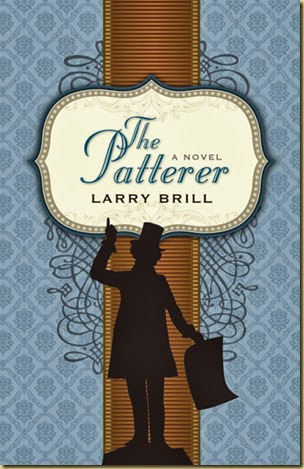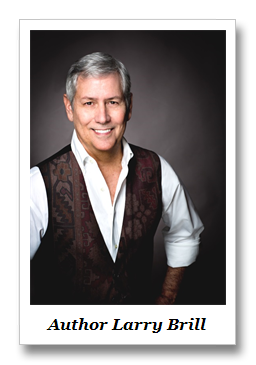It’s a pleasure today to welcome author Larry Brill to Thoughts in Progress to talk about his writing and his latest release, THE PATTERER.
Do you know what or who a patterer is? Well, here’s a brief synopsis of THE PATTERER that will explain.
In 1765 London, Leeds Merriweather is scratching out a living as a common street performer, a patterer, using his wit and storytelling skills to draw crowds and sell newspapers. Although he aspires to be a respected journalist and start his own publishing house, he is relegated to pattering by his handsome face, strong voice and straight teeth.
Inspired by a drunken chance encounter with Benjamin Franklin, Leeds assembles a zany cast of characters to become history’s first celebrity newscaster. But at the peak of his meteoric rise to fame and fortune, Leeds risks it all for the love of a conniving wench in this Dickensian comedy.
THE PATTERER is the first release in a trilogy.
Larry joins us now and has graciously answered some questions for me about this intriguing book.
Mason - What was so compiling about this story that you had to tell it and how did the trilogy come about?
Larry:
THE PATTERER was sparked by one paragraph, a throw-away observation made by Eric Burns in his book about the history of journalism in America. In tracing journalism’s roots back to Europe he mentioned that there were, at one time, these fellows known as “patterers” who would run around to various street corners of London telling stories about current events. His observation was that they could arguably be considered history’s original news broadcasters.
When I read this I knew immediately that was exactly what I had been doing for 25 years as a TV news anchor. It was easy for me to imagine what I would do if I had been born in the 18th century, born to the life of the patterer. But, really, when I created the character Leeds Merriweather, he took over the story and told it himself. I just had to do a little research and take dictation.
As for the trilogy, my first love as far as periods of history go is colonial America and the Revolutionary War. So I knew I would bring Leeds to America and have him put his irreverent observations to the events leading up to independence. And the third book gives him a chance to get involved in the birth of the nation.
Mason - With the book’s release, as you look back what was the biggest surprise that occurred while you were writing the story?
Larry:
The biggest surprise was how Leeds took over telling this story. He asked my advice for a lot of the modern day similarities because, at its heart, THE PATTERER is a story poking fun at today’s TV news business by dropping it into the middle of the 18th century. Leeds had other issues he wanted to explore and tell in his own way, and the book is so much better and funnier for it.
Mason - THE PATTERER is set in 1765 London. How did you go about doing research for this setting?
Larry:
I started with the most obvious, a couple of books about life in 18th century England. And then found Henry Mayhew’s London Labour and the London Poor, a comprehensive study of the working poor. It had quite
 a bit about the lives of street people and one of those people was the patterer. From there it came down to a lot of time spent on the internet, pulling up nuggets from various sources. When I had to cancel my research trip to London for unrelated reasons, I was able to strike up a relationship with a wonderful UK couple who are not only avid fiction fans, but history buffs as well. They were able to dash my naive American assumptions about the culture, as well as add authenticity to the locations, and phrases my characters were likely to use. They saved me from myself.
a bit about the lives of street people and one of those people was the patterer. From there it came down to a lot of time spent on the internet, pulling up nuggets from various sources. When I had to cancel my research trip to London for unrelated reasons, I was able to strike up a relationship with a wonderful UK couple who are not only avid fiction fans, but history buffs as well. They were able to dash my naive American assumptions about the culture, as well as add authenticity to the locations, and phrases my characters were likely to use. They saved me from myself.Mason - What can you tell us about Leeds that you won’t find in the book?
Larry:
That’s a tough question. As I mentioned, Leeds really took over telling his story and sometimes I feel as if he only revealed certain things to me that he saw fit, and did so only when he felt it was appropriate.
But I suspect he has more ego than he’s let on so far. He’s clearly not above exploiting the commercial side of delivering the news to a hungry audience, and despite his belief that, as he would say, “blood and lust make the world go ’round,” in his heart he’s a dreamer who thinks that he will one day make an impact on the world with his writing. I suppose we’ll have to wait for the sequel to find out.
Mason - As a TV anchor for a number of years, what do you think viewers misunderstand the most about TV news?
Larry:
I think viewers are too quick to make celebrities out of their local newscasters just because they are in your living room every night via the television. That said, it was fun and gratifying when I was in the business and somebody would stop me and ask for an autograph. But the anchors and reporters on TV at all levels are just average Joes and Janes who just happen to spend their day collecting information about things going on that may or may not interest you. It’s a job. It’s telling stories. And since the days of the early cave drawings, nothing has changed but the technology.
That brings up a question that just now occurred to me. What would Leeds Merriweather do if he had been a cave dweller painting his “news” on the walls back at the dawn of man? Sounds like a prequel to THE PATTERER. There is a story there, I think.
Mason - What can readers look forward to next from you?
Larry:
I don’t think I’m going to start on the caveman prequel to THE PATTERER just yet, but I am working on the sequel. It’s called THE PRINTER and it brings Leeds to America. But while that is percolating, I’ve been grabbed by the scruff of my neck by a contemporary story about an aging baby-boomer who is obsessed with recreating his senior year of high school--the year he considers the last decent one of his life. That “What if….” story about longing for a re-do has been done to death but always involves some sort of time travel or mystical experience. What if an aging 50-something character actually took a series of comical steps to recreate that situation without the benefit of time travel? How far would he go, and what would he do if he got the second chance he longs for? It’s Déjà vu All Over Again.
Larry, thanks for joining us and sharing this background on your book. This has been an interesting look at early journalism.
Now, let me tell you a bit about Larry.
He spent 25 years as a TV news anchor and reporter, picking up numerous awards along the way. After leaving the business in 2000 to set up a video and marketing consulting business, Larry penned his first novel, LIVE AT FIVE, a gentle lampooning of the TV news business. His second novel THE PATTERER, carries the same theme back in time to explore how today’s news clichés might play to an 18th century London theater audience.
For more on Larry and his writing, visit his website at www.larrybrill.com. THE PATTERER can be found on Amazon and Goodreads.
Here’s a delightful book trailer for THE PATTERER to entice your reading taste buds. Enjoy and thanks for stopping by today. Did you know who or what a patterer was before reading this?









Mason - Thanks for hosting Larry.
ReplyDeleteLarry - I never knew what a patterer was before. Thanks. What an interesting concept for a novel, and I like your story of being inspired by one chance bit. Thanks for sharing. I wish you success.
Larry, thanks again for joining us today. As a former journalist, I found your post most interesting. Wishing you much success with this series and your writing.
ReplyDeleteMason - Thanks for the opportunity to share the story. I had more fun writing this novel than all my others.
ReplyDelete